Everything you need to know about garden pavilions
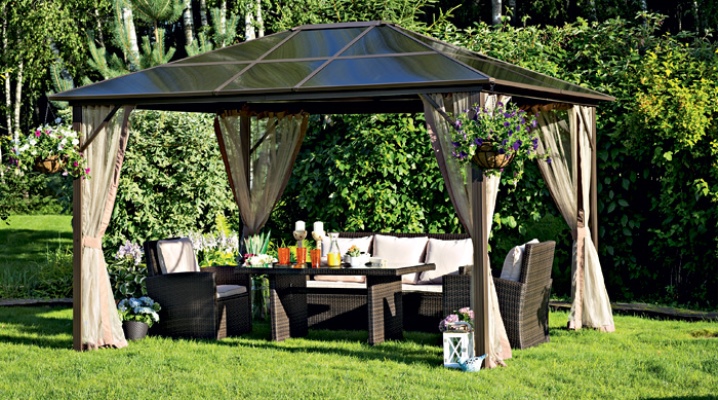
Garden pavilions are an excellent alternative to gazebos and terraces, they are cozy and fresh. You can equip a barbecue area inside, put tables, benches, get together with a noisy company.
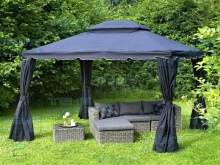


What it is?
The garden pavilion is simply an irreplaceable building for a summer residence. It can be made with your own hands, which is absolutely easy, or ordered from specialists, having previously made an approximate plan of the structure indicating the dimensions and the desired design. The structure looks like a tent, a gazebo or a summer kitchen. As materials, both natural wood and plastic, aluminum or carbonate can be used.
In the dacha pavilion, you can have a good time with friends, barbecue, celebrate birthdays or enjoy nature in the fresh air, equip a play area for children by installing a swimming pool.
The garden building comes in a variety of sizes, colors and design options.



Species overview
Country views of the summer pavilion can be made for every taste. The original buildings on the site become not only refined, but also a multifunctional addition. With their help, you can relax in the fresh air without thinking about the weather conditions. They are waterproof as all the materials used are waterproof and windproof. All entrances and exits are equipped with a magnet net - this is convenient, you do not need to constantly open or close the doors. An anti-mosquito net on the windows will not allow insects to disturb the country idyll.
Glazed buildings are very popular, they are warm and light. Pavilions with benches and an installed barbecue allow you to cook aromatic meals on the fire without leaving the premises.


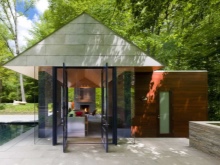
There are several forms of pavilions.
-
Round... They are small in size. This option is perfect for family tea parties.



- Hexagonal... Beautiful design idea, plenty of space inside, wind protection. The most popular type of construction.

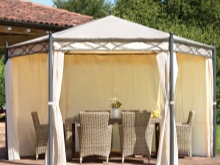

- Rectangular... Pros - quick assembly, saving space on the garden plot, over time, you can finish building side curtains or increase in size.



- Swing pavilion... Comfortable design, suitable for relaxation, can be equipped with a mosquito net. There is a great variability of colors, dimensions and cost, simple assembly (according to the instructions). Not attached to the floor, can be moved anywhere on the site.

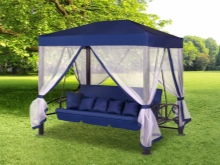

You can build a pavilion according to your own design, drawings and plans are freely available. It will be your own unique green island for recreation and entertainment.
The design of the building should be in harmony with the environment; you can make bright flowering flower beds near the pavilion or build a pond.


Materials (edit)
Materials for building a garden pavilion at a summer cottage should be selected based on their characteristics, cost and functionality. Let's list the advantages and disadvantages of materials for the pavilion.
-
Wood... Wooden buildings are environmentally friendly, there is a light aroma of wood inside the premises, they look original and are combined with any architectural structures. Of the shortcomings - they absorb moisture, are subject to the process of decay and attacks of insect pests. They are distinguished by low cost and quick installation.



- Stone... Naturalness and natural beauty, massiveness. Such a building will withstand everything and will stand for centuries. Of the minuses - it's cold inside, high cost, complicated installation.
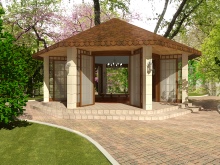


- Glass... Glass pavilions are a real work of art.They can be made from floor-to-ceiling panoramic windows or mosaic-type stained-glass windows with ink drawings. Among the disadvantages is a low operational life, constant care is required, the glass structure is fragile, and the high cost of the material.
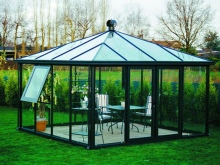
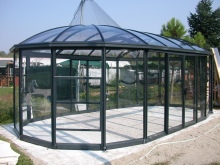

- Textile... For the manufacture of tent pavilions, waterproof materials are used - nylon, polyester, cordura, lavsan, tarpaulin, polyethylene. Pavilions of this type are made in an open form, for example, sheds, swings, tents.



- Polycarbonate... You can make a gazebo entirely of high-strength material, or make a pavilion with a polycarbonate roof. Advantages - wear resistance, water resistance, good light transmission.



- Metal. The structure is strong, reliable and durable. From the pros - easy installation, a wide range of prices, from the minuses - susceptibility to corrosion. Artistic forging can be done as a decor.



Before erecting a summer cottage, you should decide for what purposes it is needed, whether the structure will be static or portable, each option has its pros and cons... The material of the structure depends entirely on its functionality.
For a long service life, all wooden and metal structural elements should be lubricated


Criterias of choice
Choosing the right garden pavilion requires a balanced decision. All options should be considered in more detail, the functionality of the structure should be determined, how many people it should accommodate, and what material will be used for this. The choice is made up of several criteria.
-
Mobility... The pavilion can be portable or static. Portable - Ideal for outdoor trips, it is low cost and easy to assemble. Static - reliable, durable and will withstand any weather conditions.
-
Material... For light structures, waterproof fabric is suitable, for static structures - wood, metal, natural stone, polycarbonate.
-
Dimensions (edit)... Manufacturers offer standard sizes: 3x3 m, as well as 3x6, 2x3, 3x4, 4x4 meters. If the design is made independently, its dimensions can be absolutely any. To calculate the size, it is enough to calculate how many friends and relatives the pavilion should accommodate. At the same time, one should not forget about furniture - tables, chairs, benches.
-
Openness... There are two options - an open and closed pavilion. The first is designed for gatherings in good weather and a picnic, the second is able to protect from the wind, the scorching sun and rain, it is warm and cozy.

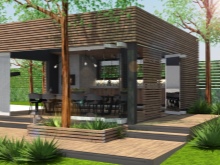

An important point is how the roof of the building is made, in priority - a spherical or round shape. This avoids leakage due to accumulation of water after rain.
Assembly features
In order to assemble a ready-made pavilion, special knowledge is not required - it will be enough to carefully study the instructions that come with the construction details.
-
Choose the location of the pavilion. An important factor is the flat terrain. If there are bumps and irregularities, they should be removed with the help of available tools. The soil should not be loose or too wet.
-
Check the contents before installation. According to the instructions, go through the list and count all the details - fittings, a set of fasteners, connectors, walls, curtains. See if there are any defective parts.
-
Assembly... This stage is not very difficult. If the instructions are not clear, you should find the video on the Internet.
-
Installation... The assembled frame of the structure should be dug into the ground. If flooring is planned, then the support will need not only to be dug in, but also to prepare a foundation for it. Paving slabs, natural stones, wood cuts can be used as flooring.

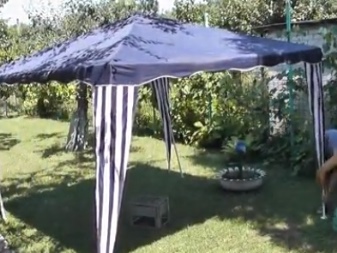
The tent pavilion is easy to assemble and operate; for convenience and comfort, you should buy a structure with mosquito nets and a domed top. When the season is over, it can be easily disassembled and put away for storage.
The garden pavilion, installed at the summer cottage, will make outdoor recreation truly unforgettable. The design can be done by hand, buy a ready-made version in a store, or order from specialists by choosing the option you like best. All of them are good in their own way, it is important to choose the one that will meet all the parameters, ideally suited to the architecture and design of the site.














The comment was sent successfully.